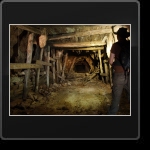The
mineralisation of the Sierra de Lújar mines have been exploited since
ancient times by Hellenes, Phoenicians and Romans, mainly for lead and to a
lesser extent for copper and silver. But it was not until the second third of
the nineteenth century when mining in this region reached significant levels
that caused a population growth in the town of Órgiva and an economic
edge when compared to the rest of neighbouring towns and
villages.
During the peak of 1860, in only a couple of years the
population grew from less than 4,000 inhabitants to more than 5,000, which
gives an idea of the bustling activity that the mining caused in what until
then had mostly been an agricultural and cattle rearing economy. During this
period, there were 59 mines for lead and 5 for copper with a total of 6
smelting plants. Fluctuations in lead prices also caused many of the family
owned mining companies to rise and fall with changes in the ownership of mining
concessions. After the obligatory stop during the Civil War, the mining
operations were taken over by the Peñarroya Mining and Metallurgical
Society (SMMP).
During the 1950's ore was removed from the mines by
trucks pulled by donkeys. Blasting was still being carried out with hammer and
chisel and gun powder. The late 1950's and early 1960's saw the introduction of
locomotives and compressed air for rock drilling, but only in the most
productive areas.
In the 1970's the extraction of fluorspar as well as
galena was started. A new track was driven around the steep mountain side which
serviced all the mines. This allowed trucks to bring ore to the treatment
plants in the small village of Tablones, making an old unreliable overhead
cable system redundant. At the end of the 1970's, an improvement in the haulage
system inside the mines was achieved by the acquisition of 5 LHD's. With the
LHD's many of the main levels that serviced the working stopes had to be
enlarged to accommodate the new haulage - around 40km of passage was
widened.
The 1980's began with a new fluorite-galena differential
flotation plant to obtain acid grade fluorite. This failed to reproduce the
promising results of laboratory tests. However, in the mid 1980's an innovation
in some reagents saw the plant achieve the promised results. This came a little
too late as the prices of the fluorite had started to drop by this point as a
result of Chinese and Mexican fluorite on the market. On the 5th August 1989,
the flotation plant was stopped and along with it the mining
operations.
In 1999 the Minera de Órgiva SL obtained the
"Lújar No. 30411" Exploitation Concession, of eight mining 'grids' that
cover part of the main mines of the Sierra de Lújar, but it was not
until 2010, with a change in ownership that production started to increase to a
significant level.
Currently the operations at the mine use a number of
LDH's to muck out the working areas and then to dump the ore into 5 ore chutes
to the lower levels where a haulage system transports the ore between 1 and 3km
to an underground treatment plant. A daily extraction of some 150 tonnes of
material is carried out each day. Ventilation is only required around the
treatment plant and on the lowest level, due to the large number of adits and
surface shafts in the mine system. An altitude difference of 550m between the
lowest and highest levels coupled with a high temperature gradient between the
outside and underground allows very effective ventilation.
The mine
produces acid, metallurgical and cement grades of fluorspar available in
different sizes. Most of the processed ore is destined for steel mills and
cement factories, with a healthy 45% of the production being exported to
Portugal, Turkey, France, Albania and Ukraine. The port of Motril some 30km
away allows a convenient overseas transport route.
|

